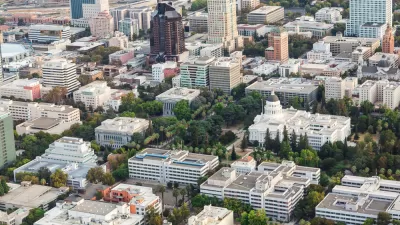It was thought that California's population would reach 40 million two summers ago, but growth continues to slow, setting records. Net migration, which includes domestic and international movement, was negative for the first time since 2010.

The state's Demographic Research Unit, a division of the Department of Finance, released its year-end report [pdf] on Dec. 20 covering the 12-month period ending on July 1, 2019, estimating that the population remained below 40 million; 39.96 million to be precise (or 40,000 shy).
During that period, the state grew by 141,300 people, which "represents a growth rate of 0.35 percent, down from 0.57 percent for the prior 12 months -- the two lowest recorded growth rates in state population since 1900." By contrast, the annualized growth rate since 2010 was 0.76 percent.
Correspondent's note: See last year's post at this time, showing 0.54 percent growth. The current report revises the nine previous estimates issued toward the end of December covering the same 12-month period since 2010. Also, note the growth rates dating back to December 2016 listed below "Related in Planetizen" at the based of this post.
A key reason for the slow growth can be found in net migration data, which includes domestic and international movement of people to and from California. Los Angeles Times reporter Julia Barajas and Sarah Parvini, who covers California’s demographics for the Times, report on the new population estimates from the Department of Finance, not to be confused with U.S. Census data.
Notably, said Eddie Hunsinger, a demographer with the Department of Finance, even though the net international migration added to the state’s population, there was substantial negative domestic net migration, which resulted in a loss of 39,500 residents. This, said the department, marks “the first time since the 2010 census that California has had more people leaving the state than moving in from abroad or other states.”
Negative net domestic migration from California has been the norm since 1990, with the state's chronic housing shortage largely to blame, but it increased last year, coupled with a decrease in new immigrants.
One key contributor to the decline in growth is the dip in immigration levels, said William Frey, a senior fellow at the Brookings Institution. Although California is still home to a large percentage of the nation’s immigrants, that number has declined.
“In the past, California would be growing because immigration would counteract domestic outmigration,” Frey added. “The outmigration is in places where housing prices are high and therefore immigration is not being able to counter that.”
Birth rate
It's not just a reduction in international migration and an increase in domestic migration. Dowell Myers, a demographer and urban planner in the Sol Price School of Public Policy at the University of Southern California, "noted that a big part of the lack of growth is the decline in birth rates — something he attributes to young couples’ inability to 'find a nest,' or affordable housing, where they would want to raise children.
At the root of the population growth slowdown is the housing crisis, which will have dire consequences if not corrected, he warns.
“We better get our act together pretty darn quick. This [economy] is as good as it’s going to get. People should be flourishing. The fact that the number of babies is going down is really worrisome.”
“We are worse off and we have the best economy,” he said.
“It’s not sustainable,” Myers added. “I think we need to have enough housing for workers to live in and for people to start families. Older people have the right to stay in their houses, but we need to make room for the young people or else we will turn into a retirement city by the sea.”
County population report
The report includes detailed growth data on all 58 counties in the state. The trend continues with inland counties having higher growth rates while "most urban coastal counties gained population at a very slow pace during this period, while several coastal counties lost population." Among them – the nation's most populous: Los Angeles saw a decrease of almost 10,000 people, largely due to a net domestic migration loss of almost 98,000 people.
Related in Planetizen:
- An Unexpected Turn for California's New State Population Report, May 6, 2019 [+0.47%]
-
California Population Growth Continues to Slow, December 28, 2018 [+0.54%]
-
California Has Been Shedding Residents—For Decades, March 3, 2018
-
California Grows by 301,000 to 39.5 Million, December 26, 2017 [+0.77%]
-
California's Birth Rate Drops to Lowest in Recorded History, December 21, 2016 [+0.75%]
FULL STORY: California population growth slowest since 1900

Alabama: Trump Terminates Settlements for Black Communities Harmed By Raw Sewage
Trump deemed the landmark civil rights agreement “illegal DEI and environmental justice policy.”

Planetizen Federal Action Tracker
A weekly monitor of how Trump’s orders and actions are impacting planners and planning in America.

The 120 Year Old Tiny Home Villages That Sheltered San Francisco’s Earthquake Refugees
More than a century ago, San Francisco mobilized to house thousands of residents displaced by the 1906 earthquake. Could their strategy offer a model for the present?

Opinion: California’s SB 79 Would Improve Housing Affordability and Transit Access
A proposed bill would legalize transit-oriented development statewide.

Record Temperatures Prompt Push for Environmental Justice Bills
Nevada legislators are proposing laws that would mandate heat mitigation measures to protect residents from the impacts of extreme heat.

Downtown Pittsburgh Set to Gain 1,300 New Housing Units
Pittsburgh’s office buildings, many of which date back to the early 20th century, are prime candidates for conversion to housing.
Urban Design for Planners 1: Software Tools
This six-course series explores essential urban design concepts using open source software and equips planners with the tools they need to participate fully in the urban design process.
Planning for Universal Design
Learn the tools for implementing Universal Design in planning regulations.
Clanton & Associates, Inc.
Jessamine County Fiscal Court
Institute for Housing and Urban Development Studies (IHS)
City of Grandview
Harvard GSD Executive Education
Toledo-Lucas County Plan Commissions
Salt Lake City
NYU Wagner Graduate School of Public Service





























